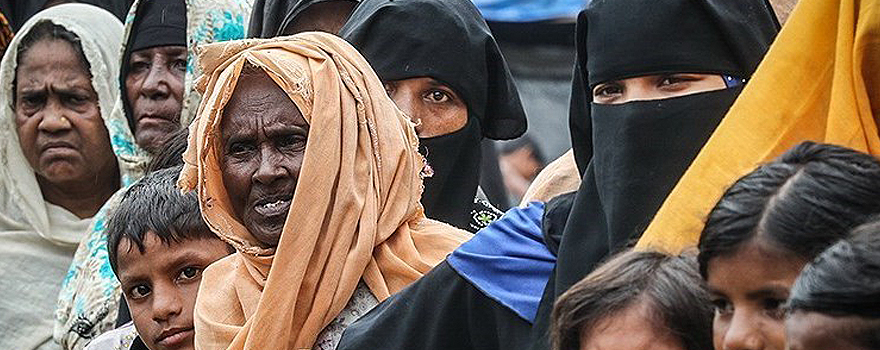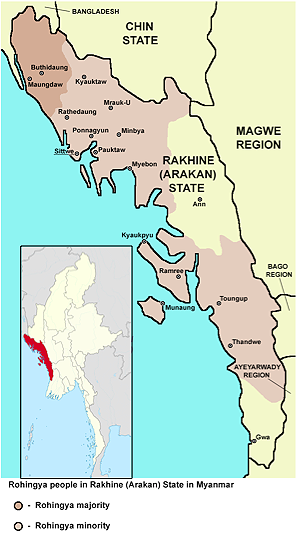Ruta de navegación
Menú de navegación
Blogs
Entries with label Myanmar .
Disputed ethnicity, British colonial-era grievances and fear of a 'fifth columnist' minority
The humanitarian crisis suffered in Myanmar by the Muslim minority Rohingyas also raises strategic issues. With the country surrounded by Islamic populations, certain ruling groups, especially Buddhist elements, fear that the Rohingyas, who are declared foreigners despite having been on their territory for generations, will act as fifth columnists. Fear of jihadist contamination is also invoked by a government that has not respected the human rights of this minority.

▲ Rohingya refugees [Tasnim News Agency/CC].
article / Alexia Cosmello Guisande
In August 2017, what was known as "the great exodus of the Rohingyas" took place in Myanmar; a year later, in 2018, the humanitarian catastrophe taking place in that country reappeared on the front pages of international newspapers. The international community, automatically, came out in favor of the Rohingya minority group . The media talked about the problem, and continue to do so, using populist language, trying to seek the emotion of the public.
The Rohingya story is little known to the public, who are generally unaware of the origin of the conflict and the Burmese government's motives. Currently, the Rohingyas are considered by the UN as "one of the most persecuted minorities in the world". In order to understand the core of the current problem, it is of great importance to make a brief analysis of the history of Myanmar, of the Rohingyas and of the relations between this minority and the country that hosts them.
History
The current state of Myanmar is a real mosaic of ethnicities, languages, religions and insurgent movements. There are 135 different ethnic groups recognized, but approximately 90% of the population is of Buddhist religion, so that the remaining denominations are considered as minorities in the country [1]. Specifically, the Rohingyas are of Muslim religion and more than half of the community is concentrated in the Rakhine or Arakan region, one of the poorest in the country. Here the population is roughly divided between: 59.7% Buddhists, 35.6% Muslims and the remaining 4.7% other religions.
The Muslims of Rakhine are divided into two groups, on the one hand, the Kaman, who despite being of another confession, share customs with the Buddhist population and are recognized and guaranteed citizenship in Myanmar by the Government. On the other hand, the Rohingyas, who are a mixture of different ethnic groups such as Arabs, Mughals and Bengalis. This second group, group , has no recognized nationality or citizenship in the State, since, despite the fact that its members have been in the country for generations, they are still considered illegal immigrants from Bangladesh.
It was between 1974, when the Emergency Immigration Law was issued, and 1982, when the Citizenship Law was passed during the dictatorial period of General Ne Win, that the Rohingyas were declared by law illegal immigrants without the right to citizenship in Myanmar. This law, together with the Government's refusal to separate them into identities, is one of the reasons why the conflict between the authorities and the Rohingyas began. To the conflict must be added the involvement of the military, which tends to instigate confrontation in the region between different ethnic groups.
Because they are stateless, which is in itself a violation of human rights, they lack recognition of other basic rights such as access to work, Education or health care, as well as freedom of movement within their own country. The conflict with this minority community goes beyond religion, as it also affects the political-economic aspects of group. They are being culturally discriminated against, economically exploited and politically marginalized.
Arguments
|
Rakhine region on the coast of Myanmar, adjacent to Bangladesh. |
To understand the Myanmar government's arguments for denying them citizenship, one must understand the history of the community. In itself, their origin is unclear, which makes their status more complex and controversial. They themselves claim to be indigenous people originally from the region they now inhabit, Rakhine. History does not contradict this, but neither does it confirm it; there is historical evidence that they have been living there for generations. On the one hand, a version of their origin, collected by historian Jasmine Chia, dates the first Muslim settlements in Arakan (former name of Rakhine) during the seventh century; these settlers continued to live in the region until the ninth century, but it was not until the fifteenth century when they settled definitively and formed a community. Versions of local historians contradict the previous version and date the first Rohingya settlements in the nineteenth century when the place was under the colonization of the British Empire, along with India and Bangladesh, so they argue that they were actually settled in Chittagong and with the transit of people and internal exodus migrated to Rakhine. Finally, French historian Jacques P. Leider states that the first time the term "Rohingya" was used was by a British doctor in the 18th century, so even though they were not yet settled in the area at that time, the ethnic group already existed.
The Second World War is considered to be the origin of the current problem. Japan wanted to invade Burma, so the British Empire decided to arm the Rohingyas to fight against the Japanese. But the group used the weapons given by the authorities, as well as the techniques learned, to defend the country against them. They burned lands and temples of other ethnic groups, mainly Buddhists. In 1944 they pushed the Japanese back, for which the British, who were still in control of the area, praised them [2].
In 1948 Burma gained independence from the British Empire, which gave several minorities representing 40% of today's Myanmar the opportunity to arm themselves and rebel against the new political system. Even today parts of the country are still controlled by these groups. Prior to independence, the country's Muslims formed the Muslim Liberation Organization (MLO), which after 1948 was renamed the Mujahid Party. This group is on the Terrorism Research and Analysis Consortium (TRAC) list of terrorist groups. The Government allowed the removal from the country's terrorist list of those groups that had signed a ceasefire with the State. This implies that the Government allows their free development and investment in these areas in need after years of isolation. In other words, these groups can now move freely around the country and participate in politics. This is not the case of the Rohingyas, who are still considered a group of foreigners and a vehicle for the expansion of jihad, from agreement with the point of view of the Myanmar Government and the Buddhists. In the recent period, the Islamic State has been expanding the Islamic religion narrative internationally, for this reason Buddhist monks (Ashin Wirathu) have called Islam a religion that directly threatens the Myanmar state and warn that it is through the Muslim minority that such violent ideas can more easily permeate the country due to the contact of elements of that minority with international terrorist groups.
The Burmese government justifies its actions against the Rohingyas on the grounds that the conflict between the two religions since the period of British colonization may lead to further conflicts. On the other hand, there is fear on the part of the Government, Buddhists and other minorities towards the Rohingyas because of their organizations such as the Arakan Rohingha National Organization or the Rohingya Solidarity Organization, which have an almost direct connection with leaders and/or members of terrorist groups such as Al-Qaeda or the Taliban.
Buddhists view with concern the rapid population growth of Muslims, which will possibly lead in the not too distant future to Muslims being in a position to outnumber the Buddhist community at issue , thus ceasing to be a minority. Linked to this fear is the fact that the country is surrounded by nations of Muslim religion, and according to Buddhists, if there were an unexpected invasion of Myanmar by some of these countries, the Rohingyas would fight in favor of the invaders, as they do not feel part of the country [3].
Resentment
While this fear on the part of Buddhists and the government itself is understandable, the human rights violations, some of which have led to real humanitarian crises, are not justifiable. In fact, behind the anti-Rohingya attitude, beyond the arguments officially invoked before the international community, there seems to be a historical resentment towards this minority for the burning of temples and land during the colonial era and a fear of open confrontation.
Clearly, a country's history marks its present and its future, and those events of decades ago explain part of what is happening in Myanmar today. While past grievances cannot be forgotten, dragging the desire for revenge from generation to generation is the best recipe for failure as a society or even tragedy. The abused Rohingya children are growing up hating the country in which they reside, which is counterproductive to the government's objectives and feeds back into the fear of one to the reaction of the other.
[1] FARZANA, Kazi Fahmida. Memories of Burmese Rohingya Refugees: Contested Identity and Belonging. "Introduction" (p. 1-40).
[2] ROGERS, Benedict. Burma: A Nation at the Crossroads. Rider Books, 2015
[3] FARZANA, K. F. op. cit. "The Refugee Problem from an Official Account" (p. 59-86).

